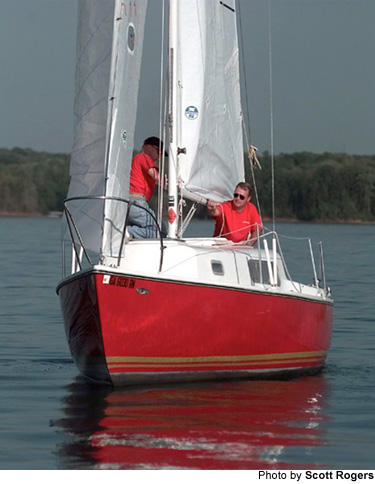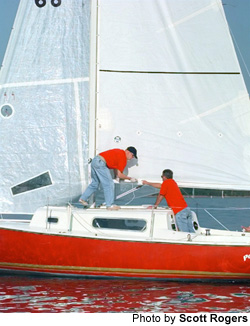
May 9, 2000 — This day was going to be different. I could feel it.
I could hear it.
A chorus of chimes serenaded me as I sat on the dock, awaiting my third attempt at sailing on Lake Lanier.
The choristers, hundreds of sailboats bobbing gently in their slips, sang to me. Halyard lines slapped against the vessels’ tall metal masts. Each line wound a little tighter, each boat with a pitch all its own.
This music is a good sign, for sailors at least. Because halyards and masts don’t sing without a little help from the wind. And wind is a necessity when it comes to sailing.
I learned this firsthand on two tranquil days in April. Turn the outboard motor off, and the boat just sits there. Peer over the rail, and your reflection stares back at you from the calm waters below.
There are far worse ways to spend a windless afternoon, however, than floating casually on Lake Lanier. 
But there would be no calm waters, no casual floating on this Wednesday evening. The chorus was getting louder.
And that was music to the ears of Pam Keene, Jim Quick and David Pope, the crew of Poppi’s Pride II, the fire-engine red Morgan 25 sailboat we were racing that night.
“Man, this is just perfect,” said Jim, 54, of Flowery Branch, as he raised the jib, or headsail. The jib began to crackle in the wind.
We set out quickly. No need to waste any of this prime sailing weather sitting at the docks.
This was my tiller time. The tiller, the steering instrument that controls the rudder, was in my hands. Best to get my tiller time out of the way before the racing began.
Jim, Pam and David are all experienced sailors — Jim and Pam are sailing instructors at the Lanier Sailing Academy. They can actually “see” wind. They peer out into the water looking for “wind shadows,” dark patches on the lake’s surface, and they chase after them.
We didn’t have any trouble finding wind last week. It was everywhere. It wasn’t long before the sail fattened roundly with air, and the boat heeled over dramatically. The side rails were skimming the water. We were moving along at more than six knots.
“How’s that feel?” Jim asked.
I believe my smile served as my response. It felt wonderful. I’ve been on boats that have traveled faster. But that this was natural — that our motor was off and out of the water — somehow made this special. Having the boat tilted 35 degrees to one side and the wind blowing in your face doesn’t hurt the excitement factor, either.
In racing, however, being heeled over too far cuts down on boat speed, because you’re traveling sideways as much as you are moving forward.
In an effort to keep the hull relatively level (a slight heel is a good thing) the crew shifts its weight, physically moves over, to the boat’s windward side. Providing this dead weight was the main purpose I served during the race.
I was, as they say in the sport, railmeat.
With every turn of the boat — a tack or a jibe — I would move into action. I would flatten my body on the cabin top, making sure to duck the boom (“It’s called the boom for a reason,” Jim said. “It’ll knock the hell out of you if you’re not careful.”) waiting for the boat to complete its turn.
Then I would scamper over to the opposite rail and sit there, awaiting the next tack or jibe.
It was easy to tell that the start of the race, part of the Atlanta Inland Sailing Club series, was drawing near. Dozens upon dozens of sailboats sailed about the waters just off the docks of Aqualand Marina.
With sails raised like fins, the boats looked like a school of sharks waiting to attack.
And then, in separate fleets, they were off.
We were given the course, which changes from week to week, beforehand. It consists of a series of marked buoys that must be traveled in a specific order and passed on a specific side.
“Mark’s at 10 o’clock, 200 yards,” yelled David, 47, of Suwanee, as we approached a marker.
Once we got closer, the crew would go into motion.
“Ready about?” hollered Pam, our helmsman from Marietta, from her position at the tiller.
“Ready!” Jim and David replied.
We were preparing to tack, or turn the boat, bow first, into the wind.
“Helm’s over!” Pam called. She was pulling the tiller all the way to one side.
Jim and David moved quickly, trimming the jib sail from one side to the other. Jim unwound the jib line, or sheet, from the winch on his side of the boat and fed it forward. Meanwhile, David, on the other side of the boat, pulled hard on the sheet, moving the jib to his side. He then wound the sheet tightly around his winch, inserted the winch handle and tightened some more.
I slid across the cabin top to the other rail.
The entire process takes just a few seconds.
After more than an hour of racing, dark clouds began to chase us quickly from behind. Flashes of lightning brightened the blackening sky.
The wind began to whirl. The water became choppy.
I looked behind us. White sails seemed to glow in the dark. Red lights shone from the boats’ bows. That’s all I could see. It was an odd contrast in colors.
Some boats had dropped their headsails, but we sailed on. We were now racing against the storm and it was fast approaching. Lightning that flashed before us became our finish line.
The wind intensified. White caps formed as the water churned. We had passed seven knots long ago.
“This is sailing, Dan,” Pam screamed through the rain.
No, I thought as we crossed the finish line.
This is living.
